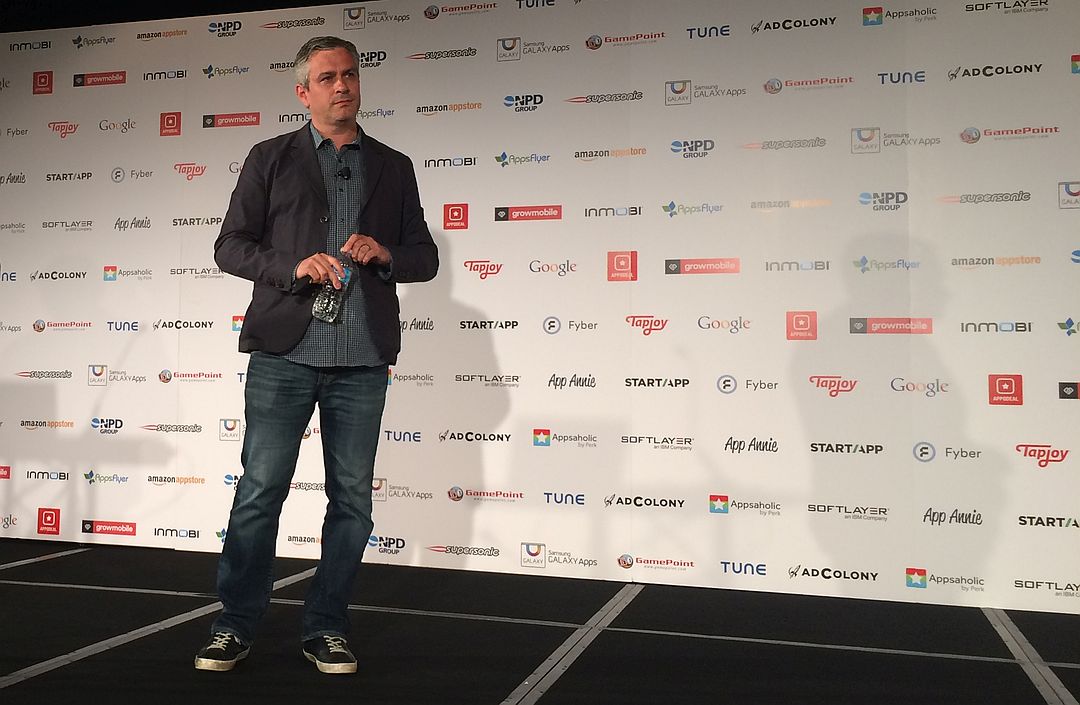Neil Young has already had a vast range of experiences in gaming, as an executive at Electronic Arts, founder of mobile game company ngmoco (later purchased by DeNA), and now CEO and founder at N3TWORK, once again entering the mobile game business. While some may feel that the mobile game market is overcrowded and that the opportunity isn’t great for game companies new or old, Young has just the opposite stance. Peak Mobile Not even… was the title of his talk at Casual Connect 2015 in San Francisco, where he proceeded to demolish the idea that mobile games were not a good place to be looking for growth.
Young pointed out that while in the West almost 80 percent of the market has a smartphone, Japan reached that point in 2010 with their Internect-connected feature phones. What happened to the mobile game market in Japan after that “You saw a 7X growth in ARPU from the end of 2010 to the end of 2014 in Japan,” Young noted. Japan has an astonishing average revenue per user compared to any other country, which Young attributes to continuing innovation by developers. That can happen elsewhere, Young contends, in a few years. “The Western market will be 8 to 10 times its current size,” Young said. “The #1 Western game will approach $10 billion per year in revenue. The rise of those high-LTV games will change the marketing landscape. It’s going to change how you design, develop, market, and operate the games.”
Young sat down with [a]listdaily after his talk to bring some more details for his vision of the mobile game future and the role that N3TWORK will play in it.
When you talked about how games would increase long-term value with innovation in the games, it seemed to me you are implying a very close relationship between game design and marketing. Do you believe marketing and design would have to work closely together in order to achieve your vision?
There is no separation. There’s a fundamental equation at the core of these businesses. The profitabilty of your game is the life-time value (LTV) minus the cost of acquiring a customer. That equation has to be owned by everyone inside your business. I’m approaching that from a business perspective, but that doesn’t mean that you don’t want to be building things that are creatively rewarding and great as games — they have to be. The LTV part of that equation breaks down into this: How much money do you make, and how long do you keep people What’s the profile of those users Are those users a very small segment that are deeply engaged, or is it a broad segment of people that are less engaged?
Truly understanding the profile of the customers that are really driving your monetization becomes very important, which in turn leads you to the type of features that you would want to build. If you looked at the LTV over 365 days and realized you only only retain 2 percent of your audience after day 180, but 2 percent makes up more than 50 percent of that year’s revenue, your going to deliver very different types of features than if it’s “we make the lion’s share of our revenue from the front end on this game.”

The changes you’d make to the game would be very different if you’re just trying to retain people than if you’re trying to change that 2 percent to 4 percent or even 8 percent, wouldn’t they?
Exactly. There’s the revenue that you generate, and then there’s the relationship with the customers that you retain and the customers that you acquire. The other function of LTV is retention, so you want to figure out which features are going to drive better retention across my audience or for a given segment of my audience. That 2 percent , we don’t want them going on Day 365 — we want them to stay for seven years. Because if they stay for seven years then it’s like a seemingly infinite LTV. Once you’ve got that in place, you might say ‘Look, there’s this other group of people that sticks around for 90 days, who plays the game for 90 days that wouldn’t play it for 180 days What do we need to do for that segment of the audience?’
So what is the relationship between marketing and product development, or what should it be?
There is no relationship because they’re the same thing. At the center of what you are doing is this equation, and your business’ success is a function of these features, how well they retain and engage the audience, and the cost of acquiring a customer and how those features can aid or support that.
Before he left us so suddenly, Nintendo’s CEO Satoru Iwata had said that he was hoping with their mobile games being created with DeNA that they could get a small amount of money from a very large number of people, rather than a large amount of money from a very small percentage of the audience. Is this a realistic hope?
There are two ways to solve that problem. One way is to try to build a game that is broadly appealing and that monetizes really well. That $10 billion a year game that I talk about in my deck — in five years’ time I can see a path to a game that generates $10 billion a year in the West — for that to work, it has to be a scaled product. It has to be something that appeals to a really broad audience of people but monetizes at this really high level. That’s really what Puzzle & Dragons is in Japan. That is seen as a broadly appealing game, it’s been downloaded by over 30 percent of the population — it’s hard to find games in the West that have that kind of penetration other than Candy Crush or FarmVille. Nintendo is awesome as a partner for DeNA in that regard, because if there’s one brand that everyone on the planet knows, it’s Nintendo. The number of people that have played Mario or Zelda or Pokemon… these are incredible things.
Another way you can tackle the problem is you can say ‘It’s OK there’s only 2 percent or 4 percent of a given audience sticking around for a long time — and by the way, I don’t think 2 or 4 percent is a very good number, to be clear.’ What that really says is that of all the people we have promoted that title to, only 4 percent have become lifelong fans. What are the other 96 percent lifelong fans of? And how do you build a portfolio and start stacking these 4 perccent’s on top of one another so you can start programming your content to these core fan bases? That’s a little bit of like how cable television evolved. You went from trying to appeal to everyone to ‘look, there are these niches we can monetize at a very different level.’ It’s that way in the game space, too. DeNA has been quite successful doing that. You can take the same game framweork and build an audience by narrowcasting to people.

